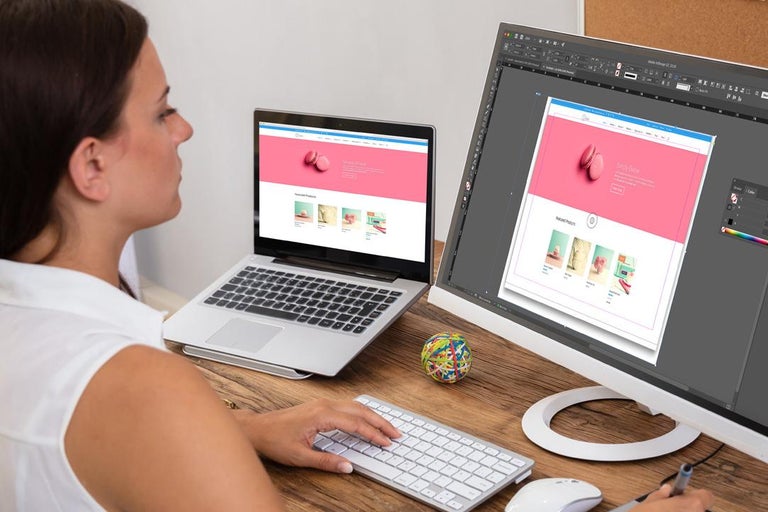Search and equire about leading web design courses on Training.com.au – from short courses right through to national recognised qualifications.
Web Design Courses



Search and equire about leading web design courses on Training.com.au – from short courses right through to national recognised qualifications.
Our ICT40120 Certificate IV in Information Technology (Web Development) provides a solid base of knowledge and highly regarded skills to equip you to become a website developer. This is a career on the way up with strong demand for the skills that help...

Demand for web development skills is increasing steadily across all industries, with the number of roles in Australia set to grow 9.2% by 20241. The sheer number of developers needed to serve the millions of websites and digital services offered by mod...

Always wanted to build your own website? Maybe looking to make a career out of it? Learn all the modern methods of desiging, developing, and administrating websites through our ICT40120 – Certificate IV in Information Technology (Web Development)...

So you’re interested in the ICT30120 Certificate III Information Technology qualification – but you’ve got a special interest in Web Development too? Then this is the perfect place for you because we’ve put together a specifical...

Why choose the Front End Developer? Front-end development involves building and implementing the user-facing or client-side components of a website or web application. During the Front-end Development PLUS course, you’ll have access to over 200 hours o...

Want to enter a fast-paced, growing profession that lets you showcase your technical and creative skills? Take the next step in your career with our online web design courses. These flexible learning programmes will equip you with the skills you need t...

Web Designers combine artistic and design expertise with technical skills to build and design websites for a variety of different clients. Web designers need to be able to create sites that provide an exceptional user experience at the same time as being aesthetically appealing to the intended audience.
This involves a blend of talents and means that each Web Designer tends to have a fairly unique approach to their work. Web Designers need to constantly update their skills to reflect changing trends and fresh techniques as they come on-stream, especially as the industry is so technology-focused.
The profession is quite a new one, which has developed as more and more organisations and businesses are discovering the benefits of having a strong online presence. Web design is constantly changing, so a flexible approach is vital!
Web design courses can equip students to work as a:
Web design is a relatively new profession, with demand being directly linked to the rise of the Internet as a marketing arena. More businesses are starting to follow emerging trends in Search Engine Optimisation (SEO), digital marketing and user experience, making Web Design a much more profitable sector.
The median salary for web design professionals is AUD $51,256, however, this can increase by a substantial amount with additional experience and education. It also depends on the type of work, with many Web Designers being employed on a freelance basis. Pay also varies from city to city, with major cities such as Sydney, Perth and Melbourne tending to offer higher salaries than Adelaide and Brisbane.
Demand for website design professionals is high and predicted to increase – it is thought that between 25,000 and 50,000 additional web designers will be needed in Australia in the next three years.Interestingly, nearly two-thirds of web designers are male and work situations
Interestingly, nearly two-thirds of web designers are male and work situations tend to vary in this industry. While some are employed full-time, there’s also a high number of part-time workers, with working from home also being a popular means in web design.
A Certificate in Web Design is the prime place to start your journey to this exciting, creative career. A Certificate IV in Digital Design, for instance, is a practical course that’s been designed by experts in graphic design and website development. It’s intended to give students the basic skills and knowledge they need to begin a career in the virtual creative industries, including digital marketing or digital design.
Elements include communication design, photo editing, graphics, visualisation and a range of other creative and technical information and abilities which students need to successfully pursue a design career. The course is intended as a first step into the world of website design. Successful students will leave the course equipped with the skills they need to begin working as web designers, either for a company or on a self-employed or freelance basis.
Whether you’ve already done a Certificate in Web Design or looking for a more comprehensive overview of the industry; a Diploma of Web Design is perfect for you. It may also form the basis for diversification into further study, including a Bachelor Degree course incorporating specialities such as visual communication or digital interactive media.
On completion of a Diploma of Web Design, learners should be able to create a dynamic and appropriate user interface that combines effective visualisation with sound technical features that ensure the site is easy to navigate, has a payment system that works well and which is straightforward for users to work with.
To work successfully in this field, candidates usually need to possess skills such as:
Designers will usually spend much of their day coding or be using appropriate software to create sites. They will also spend time consulting the client’s brief on the type of audience they wish to attract and design the visual aspects of the site in line with this information.
Once designed, the site will need to be tested and initial versions approved by the client. Designers will then have to respond to client feedback, altering the site until it’s exactly what’s required.
Communication forms a large part of the designer’s role, either with the client or other members of the team.
Most of the day will be spent at the computer, either actually creating the site, answering emails or liaising with other members of the team.
For senior designers, the day may also involve mentoring and communicating with more junior members of the staff, as well as providing managerial support.

We’ll email you updates on job trends, career advice, study tips, news and more.